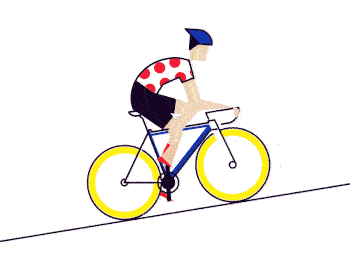
Cycling is a fantastic sport that offers a wide range of challenges and rewards. One such challenge is tackling elevation gain, which refers to the total vertical distance climbed during a ride.
Elevation gain plays a crucial role in cycling performance, providing physical and mental benefits to riders.
In this article, we will explore the importance of elevation gain, training methods, techniques for climbing, safety considerations, and strategies for efficient climbing. So, buckle up, grab your helmet, and let’s delve into the world of elevation gain in cycling.
What is Elevation Gain?

Elevation gain, also known as climbing, is the measurement of vertical distance covered during a cycling ride. It represents the cumulative ascent of a route, including all the hills, mountains, and inclines encountered. Elevation gain is typically measured in feet or meters and is an essential factor in determining the difficulty and intensity of a ride.
Importance of Elevation Gain in Cycling
Elevation gain is more than just a numerical value. It adds excitement, challenge, and variety to your cycling adventures.
It pushes your physical limits, tests your mental resilience, and rewards you with a sense of accomplishment. Incorporating elevation gain into your rides helps improve overall fitness, strength, and endurance.
How to Calculate Elevation Gain in Cycling: The Formula 🚵

Calculating elevation gain in cycling allows you to quantify the total vertical distance covered during a ride and provides valuable information about the intensity and difficulty of your cycling routes.
While modern cycling computers and GPS devices can automatically calculate elevation gain, it’s helpful to understand the underlying formula.
The formula for calculating elevation gain in cycling is as follows:
Elevation Gain = Sum of all positive changes in elevation along the route
To calculate elevation gain manually, follow these steps:
- Prepare your ride data: Ensure you have recorded your cycling route using a GPS device, smartphone app, or cycling computer that tracks elevation data.
- Obtain the elevation data: Export or retrieve the recorded data, which typically includes the GPS coordinates and elevation readings for each point along your cycling route.
- Identify positive changes in elevation: Review the elevation data and identify all instances where the elevation increases along the route. These points represent climbs or uphill sections.
- Sum the positive changes: Add up all the positive changes in elevation to calculate the elevation gain for your ride. Disregard any negative changes or downhill sections, as they do not contribute to the overall elevation gain.
By following this formula, you can manually calculate the elevation gain for any cycling route.
However, it’s worth noting that modern cycling technology and GPS devices provide accurate and automated elevation gain calculations, which simplify the process for cyclists.
Calculating Elevation Gain in Cycling Using Mobile Apps & GPS Watches 📱
In today’s technology-driven world, mobile apps and GPS watches have become valuable tools for cyclists. These devices not only track your speed, distance, and duration but also provide automatic elevation gain calculations. Here’s how you can calculate elevation gain in cycling using mobile apps and GPS watches:
- Choose a reliable mobile app or GPS watch: There are numerous cycling apps and GPS watches available that offer accurate elevation tracking. Popular apps like Strava, MapMyRide, and Garmin Connect, as well as GPS watches like Garmin, Wahoo, and Suunto, have built-in elevation tracking features.
- Record your cycling route: Before you start your ride, activate the GPS tracking feature on your mobile app or GPS watch. This ensures that your device accurately captures the necessary data, including elevation changes.
- Complete your cycling ride: Cycle your chosen route while your mobile app or GPS watch records your ride. During the ride, the device will continuously collect data on your location, speed, and elevation.
- Review your ride data: Once you finish your ride, access the recorded data on your mobile app or GPS watch. Navigate to the specific ride or activity and locate the elevation gain information.
- View elevation gain statistics: Most mobile apps and GPS watches provide detailed ride summaries, including elevation gain. The elevation gain data is usually displayed in either feet or meters, representing the total vertical distance climbed during your ride.

By using a reliable mobile app or GPS watch, you can easily track and calculate elevation gain in cycling. These devices utilize built-in GPS technology to accurately record and analyze your ride data, including elevation changes along the route.
With the convenience of mobile apps and GPS watches, you can effortlessly monitor your elevation gain, track your progress over time, and challenge yourself with more demanding routes. So, grab your smartphone or GPS watch, start recording your rides, and let technology handle the calculations while you focus on conquering those climbs.
Factors Affecting Elevation Gain
Several factors influence the elevation gain experienced during a cycling ride. Understanding these factors can help you plan and prepare for your rides more effectively.
Terrain: The type of terrain you ride on significantly affects elevation gain. Mountainous regions and hilly landscapes offer greater opportunities for elevation gain compared to flat terrains.
Gradient: The steepness of the inclines encountered during your ride directly impacts elevation gain. The steeper the gradient, the more challenging the climb and the higher the elevation gain.
Distance: The overall distance covered in a ride also affects elevation gain. Longer rides tend to have higher cumulative elevation gain, providing greater challenges and opportunities for training.
Training for Elevation Gain

To conquer elevation gain, specific training strategies can help you improve your climbing abilities and overall performance.
Building Strength: Strengthening your leg muscles is essential for conquering elevation gain. Incorporate resistance training exercises like squats and lunges into your routine to develop strong leg muscles.
Hill Repeats: Hill repeats are an excellent training technique to build climbing power. Find a challenging hill and repeatedly climb it at a high intensity, allowing for recovery periods in between. Gradually increase the number of repeats over time to improve your climbing prowess.
Endurance Training: Long endurance rides simulate the demands of climbing and improve your aerobic capacity. Focus on maintaining a steady pace and gradually increase the duration and intensity of your rides.
Benefits of Elevation Gain in Cycling 🚲
Apart from the physical challenges, elevation gain offers several benefits to cyclists.
Increased Cardiovascular Fitness: Climbing requires sustained effort and elevates your heart rate. Regular exposure to elevation gain improves cardiovascular fitness, enhancing your overall endurance and stamina.
Improved Leg Strength: Uphill climbs target the major leg muscles, including quadriceps, hamstrings, and calves. The repetitive motion of climbing strengthens these muscles, resulting in improved power and efficiency on the bike.
Mental Toughness: Tackling challenging climbs builds mental resilience and tenacity. Overcoming the physical and mental barriers associated with elevation gain instills a sense of accomplishment and boosts your confidence as a cyclist.
Techniques for Climbing with Elevation Gain
To optimize your climbing performance, it’s essential to master specific techniques.
Pacing: Pace yourself when climbing. Start at a comfortable pace, maintain a steady rhythm, and avoid going all-out at the beginning. Find a pace that allows you to sustain your effort throughout the climb.
Gear Selection: Use appropriate gear when climbing. Shift to lower gears to maintain a consistent cadence, enabling you to conquer steep gradients without excessive strain.
Body Positioning: Position your body correctly when climbing. Keep your upper body relaxed, maintain a firm grip on the handlebars, and shift your weight forward to maintain traction and stability.
Safety Considerations for Cycling with Elevation Gain
Cycling with elevation gain requires careful consideration of safety measures to ensure a safe and enjoyable experience.
Proper Bike Maintenance: Before tackling challenging climbs, ensure your bike is in optimal condition. Regularly check and maintain your brakes, tires, gears, and overall bike functionality to prevent any mechanical issues during your rides.
See also: How To Tighten Brakes On A Bicycle 🔧
Protective Gear: Always wear appropriate protective gear, including a well-fitting helmet and cycling gloves. Consider additional safety equipment like knee pads and elbow guards, especially for more technical descents.
Weather Conditions: Be aware of the weather conditions before heading out for a ride. Rain, strong winds, or extreme temperatures can significantly impact your safety on the bike. Dress accordingly and adjust your plans if needed.
Strategies for Efficient Climbing

To optimize your climbing performance and conserve energy, consider the following strategies.
Energy Conservation: Conserve energy by maintaining a steady pace, avoiding sudden bursts of speed, and focusing on efficient pedal strokes. Relax your upper body, breathe deeply, and engage your core muscles to improve overall efficiency.
Breathing Techniques: Controlled breathing can enhance your climbing performance. Practice deep belly breathing to oxygenate your muscles and maintain a relaxed state throughout the climb.
Mental Strategies: Climbing can be physically demanding and mentally challenging. Employ mental strategies such as positive self-talk, visualization, and focusing on small milestones to stay motivated and overcome mental barriers.
Incorporating Elevation Gain in Training Plans
To improve your climbing abilities, incorporate elevation gain strategically into your training plans. Gradually increase the intensity and duration of your climbing workouts, monitor your progress, and set realistic goals. Consider working with a cycling coach or joining a local cycling group to gain insights, support, and motivation.
Conclusion
The Elevation gain in cycling opens doors to new challenges, rewards, and personal growth. By embracing the hills and mountains, you can elevate your fitness, strength, and mental resilience.
Remember to train strategically, master climbing techniques, prioritize safety, and incorporate elevation gain into your cycling adventures. So, gear up, embrace the heights, and conquer new summits on your bike.
FAQ
What does Strava elevation gain mean?
Strava elevation gain refers to the total vertical distance climbed during a cycling or running activity recorded on the Strava platform. It represents the cumulative ascent encountered along the route.
What is considered good elevation gain?
Good elevation gain is subjective and depends on factors such as fitness level, terrain, and personal goals. For some, a few hundred feet of elevation gain may be challenging, while others may aim for thousands of feet during a ride or run.
Is Strava elevation gain accurate?
Strava elevation gain is based on GPS data and can be subject to inaccuracies. Factors like GPS signal strength and terrain variations may affect the accuracy. However, Strava continuously works to improve elevation calculations.
What is the difference between elevation gain and maximum elevation on Strava?
Elevation gain represents the total vertical distance climbed throughout an activity. Maximum elevation, on the other hand, indicates the highest point reached in terms of altitude during that particular activity.
What does “biggest climb” mean on Strava?
“Biggest climb” on Strava refers to the segment with the highest elevation gain recorded within a specific distance. It highlights the most significant ascent along a route, providing a challenge for athletes to conquer.
Why does my Strava show elevation instead of pace?
Strava automatically adjusts the displayed metric based on the type of activity recorded. If your activity is set as a cycling or running activity, Strava will show elevation gain and other related metrics rather than pace.






